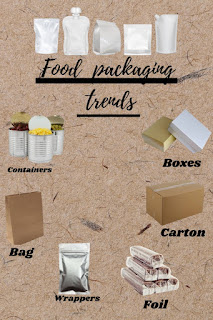Food packing trends
It’s never been easier for food companies to reach their customers. Packaging preserves food quality as well as attracts customers. Most customers are likely to judge the food quality from the package.
Which packaging goes well with the food products? Well, there are many types to choose, from glass, paper, corrugated to plastic. However, not all food packaging is the same. All have their benefits and some downsides as well.
The right packaging techniques can go a long way to preserve the food quality and one can even use existing containers.
The demand for packaging has been growing exponentially as the packaging design is the most important approach to draw eyeballs of customers. Besides branding, the packing design of your product can either make or break you in the industry.
There are different types of food packaging:
● Canned food packaging: Canning is a method of preserving foods for long periods by packing them in airtight containers. Canning was first developed in the late 18th century as a way to provide a stable food source for soldiers and sailors at war.
● Foil packaging: Aluminium packaging is light, flexible and easily recyclable. Furthermore, it is hygienic, non-toxic and helps in keeping the aroma of foods. It keeps the food fresh for a long time and protects from light, ultraviolet radiation, oils and grease, water vapour, oxygen and microorganisms. Aluminium foil in food packaging is generally harmless to health. Acid or salty foods should not come into direct contact with aluminium, but composite films with aluminium layers can be used.
● Bags: LDPE(low-density polyethene) bags are most commonly used as food and utility bags as it is made from low-density polyethene. They have high clarity and are extremely breathable too, making them a popular choice in the fast-paced setting of a commercial restaurant.
● Carton packaging: Folding carton packaging kickstarted the packaging industry over a hundred years ago and is now a billion-dollar industry today. Today, packaging boxes are being used in almost all products, such as electronics, toys, cosmetics, food and bakery products and a lot more.
● Boxes: Monocartons are simple boxes that are made from paperboards. Mono cartons are often used as retail boxes as they can be easily printed, laminated and customized. They also offer protection from minor splashes, drops and bumps.
● Wrapper packaging Protects vulnerable products from damage whilst in transit and from contamination or damage by moisture, humidity, gases, microorganisms, insects and light.
Preserves products for longer, which reduces waste by giving people more time to use or consume them. Shrinkwrap is a polymer plastic that wraps tightly around whatever it is covering when the shrink wrapping is used as an overwrap to protect the retail packaging or to bundle multiple packages.
● flexible packaging: Flexible packaging consists of any package or that shapesckage that’s shape can be readily changed. It is constantly evolving to meet ever-increasing
consumer demands while complying with stringent food and safety regulations.
Flexible packaging offers a broad range of protective properties while minimizing materials and
costs.



Comments
Post a Comment